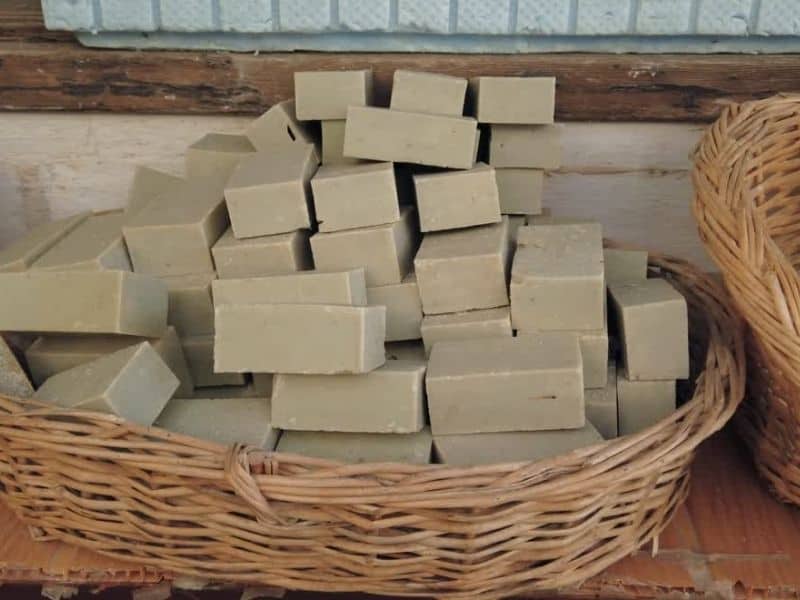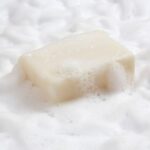Hot process soap making offers unique benefits compared to its cold process counterpart. In this article, we’ll dive into the world of hot process soap and explore factors affecting curing time, troubleshooting common issues, essential tools, and safety precautions.
Hot process soap is ready in 24-48 hours. However, allowing it to cure for 1 to 2 weeks will help get rid of excess moisture, giving you the best results possible. In addition, factors like ingredients, humidity, and soap size can affect curing time.
While hot process soap may be safe to use within 24-48 hours, it’s essential to consider the benefits of additional curing time. Allowing your soap to cure for 1 to 2 weeks helps it achieve optimal hardness, lather, and longevity.
This extra time also allows the soap to mellow, creating a gentler product for your skin. By taking these factors into account, you can ensure that your hot process soap offers the best possible experience for you or your customers.
Let’s take a closer look at some factors related to hot process curing time.
Factors Affecting Hot Process Soap Curing Time
The ingredients you choose play a significant role in curing time. Soaps containing more hard oils, such as coconut or palm oil, generally cure faster.
Conversely, soaps with softer oils, like olive or sunflower oil, may require additional time. Experimenting with various oil combinations helps you find the perfect balance for your soap’s consistency and curing time.
Curing time is also influenced by environmental factors, such as humidity and temperature. In areas with high humidity, soap takes longer to cure.
Aim for a room temperature between 70°F to 75°F for optimal curing conditions. Avoid placing your soap in extreme temperatures, as they can adversely affect the soap’s texture, consistency, and overall quality.
The size and shape of your soap bars directly impact the curing time. Thicker, larger bars need more time to cure than thinner, smaller ones.
Utilizing soap molds with consistent sizes helps ensure even curing across all your soap bars.
Ideal Curing Time for Hot Process Soap
Hot process soap typically requires less curing time compared to cold process soap. The average curing time for hot process soap ranges from 1 to 2 weeks.
However, some soaps may benefit from a longer curing period, up to 4 weeks, to achieve optimal results.
To determine if your soap is ready, perform the “touch test.” Gently press your finger onto the soap’s surface. If it feels firm and dry, it’s likely cured. If it’s soft or sticky, allow it more time to cure.
Additionally, you can monitor the soap’s weight, as cured soap will weigh less due to water evaporation.
Taking the time to cure your hot process soap offers several advantages. Properly cured soap lasts longer, produces a richer lather, and feels smoother on the skin.
Ensuring your soap is adequately cured guarantees a high-quality, enjoyable bathing experience for you or your customers.
Troubleshooting Common Curing Issues
Overly soft soap
If your hot process soap remains soft after the expected curing time, it might be due to excess moisture or an imbalance in your oil mix. To remedy this, extend the curing period, or adjust your recipe to include more hard oils.
Crumbly texture
A crumbly texture can result from using too much lye or insufficient water in your recipe. Double-check your measurements and ensure that you’re using the correct lye-to-water ratio. If your soap is already crumbly, try grating it and rebatching with additional water or oil.
Tips for fixing problems
To fix issues, consider the following:
- Reevaluate your recipe to ensure proper proportions of oils, lye, and water.
- Double-check your measurements and lye-to-water ratio.
- Ensure optimal curing conditions, including humidity and temperature control.
- Be patient and give your soap more time to cure if needed.
Tips for Accelerating Curing Process
Good airflow is crucial for speeding up the curing process. Place your soap bars on a well-ventilated rack, allowing air to circulate around them. Keep the curing area free from dust and debris.
Maintaining a consistent temperature accelerates curing. As mentioned earlier, aim for a room temperature of 70°F to 75°F. Avoid placing soap near heat sources or in direct sunlight, as this may cause melting or sweating.
Rotate your soap bars every few days during the curing process. This ensures that all sides of the soap receive equal exposure to air, promoting even drying and faster curing. By implementing these tips, you can shorten the curing time and enjoy your handmade soap sooner.
Essential Tools for Hot Process Soap Making
Safety equipment
Safety should always be a top priority when making hot process soap. Equip yourself with safety gear like gloves, goggles, long-sleeved clothing, and a mask to protect against lye fumes.
Soap molds and cutters
Soap molds determine your soap’s final shape and size. Silicone molds are popular due to their flexibility and easy release. For uniform bars, use a soap cutter or a straight-edged knife.
Thermometers and timers
Accurate temperature control is crucial for successful hot process soap making. Use a reliable thermometer to monitor oil and lye solution temperatures. A timer helps track cooking and cooling times.
Hot Process Soap Safety
In addition to the safety gear mentioned earlier, keep a bottle of vinegar on hand to neutralize lye spills. Work in a well-ventilated area to avoid inhaling lye fumes.
Safety Procedures
- Carefully measure and mix your lye solution in a well-ventilated area.
- Slowly pour lye into water, never the reverse, to avoid dangerous reactions.
- Keep children and pets away from your soap-making workspace.
- Clean up spills immediately using vinegar to neutralize the lye.
Hot Process Safety Tips
- Educate yourself on the properties and handling of lye before starting.
- Follow recipes from reputable sources and double-check measurements.
- Always wear appropriate safety gear and follow safety procedures.
- Don’t rush the process; take your time and pay attention to details.
Adhering to these safety guidelines, you can create beautiful hot process soaps while ensuring a safe and enjoyable experience.
Frequently Asked Questions
Ingredient selection plays a significant role in curing time. Soaps with harder oils, like coconut or palm oil, tend to cure faster, while those with softer oils, like olive or sunflower oil, may need more time.
High humidity can prolong the curing time, while maintaining a consistent room temperature of 70°F to 75°F helps promote optimal curing conditions.
Thicker, larger soap bars need more time to cure than thinner, smaller ones. Using soap molds with consistent sizes ensures even curing across all soap bars.
Perform the “touch test” by gently pressing your finger onto the soap’s surface. If it feels firm and dry, it’s likely cured. If it’s soft or sticky, allow it more time to cure.
Properly cured soap lasts longer, produces a richer lather, and feels smoother on the skin. Ensuring your soap is adequately cured guarantees a high-quality, enjoyable bathing experience.
A crumbly texture can result from using too much lye or insufficient water in your recipe. Double-check your measurements and ensure that you’re using the correct lye-to-water ratio.
To speed up the curing process, ensure proper ventilation, maintain consistent temperature, and rotate your soap bars every few days for even exposure to air.
Conclusion
In conclusion, understanding the ins and outs of hot process soap curing is crucial for creating beautiful, high-quality soaps that stand the test of time.
By considering factors such as ingredients, humidity, temperature, and soap size, you can optimize the curing process for your unique creations.
Troubleshooting common issues, using essential tools, and following safety precautions ensure a successful and enjoyable soap-making experience.






